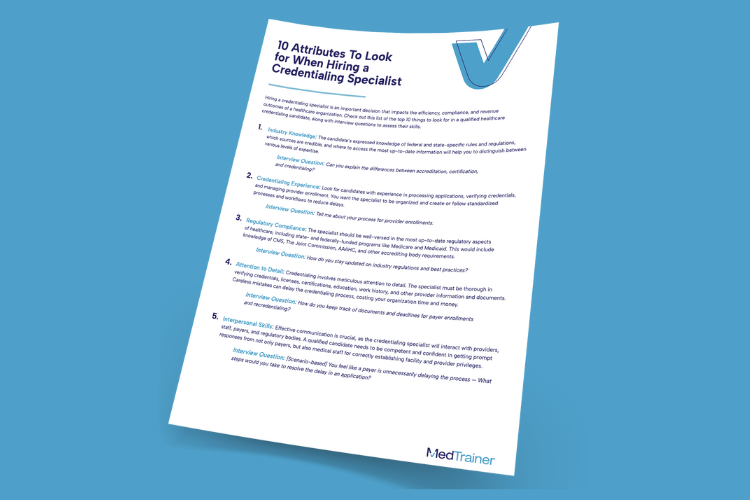Credentialing in healthcare is one of the first steps to a provider being able to practice. The rigorous process safeguards the integrity of the field, ensuring that only competent and qualified individuals are granted the privilege to provide care. In this blog post, we’ll explore what credentialing entails, its significance, and why it remains an indispensable aspect of healthcare.
What Is the Purpose of Credentialing in Healthcare?
Provider credentialing in healthcare serves two main purposes: maintaining healthcare standards and ensuring medical proficiency.
Healthcare Credentialing Standards
Healthcare credentialing standards are established benchmarks that ensure medical professionals possess the necessary qualifications, experience, and skills to deliver quality care. These standards, set by accrediting bodies and institutions, establish a consistent level of patient care by ensuring that practitioners meet rigorous criteria in terms of education, training, and expertise.
Importance of Credentialing in Medicine
The importance of credentialing in medicine can’t be emphasized enough. For each provider, credentialing proves their medical proficiency. By rigorously assessing and verifying a medical professional’s qualifications and practice history, credentialing instills trust among patients, reduces potential liabilities for healthcare organizations, and underscores the commitment of the medical community to uphold the highest standards of competence and ethics.
Benefits of Healthcare Credentialing
Credentialing offers numerous benefits, including:
Patient Safety: Ensures only qualified professionals provide care, reducing potential medical errors.
Credibility: Bolsters the reputation and trustworthiness of credentialed healthcare providers and organizations.
Risk Management: Minimizes institutional liabilities by validating staff competence.
Compliance Assurance: Helps healthcare facilities adhere to regulatory requirements and standards.
Trust Building: Fosters patient confidence in the skills and expertise of their healthcare provider.
Increased Revenue: Credentialing can lead to preferred provider status with insurers and more patient referrals.
Stakeholder Confidence: Reassures investors, partners, and other stakeholders of an institution’s commitment to quality care.
How Does the Healthcare Credentialing Process Work?
The healthcare credentialing process is a meticulous system set up to validate the qualifications, skills, and experience of medical professionals. Below are the steps that need to be completed in order for a provider to be fully credentialed:
Healthcare Credentialing Process Steps
- Application Submission: The healthcare professional begins the process by submitting a detailed application, providing information on their education, training, work history, licenses, certifications, and references.
- Primary Source Verification: This step involves directly verifying each submitted credential with the issuing institution, agency, or board to ensure its validity.
- Peer References: Colleagues familiar with the professional’s work may be contacted to provide confirmation of the professional’s competence and ethical standing.
- Committee Review: A designated credentialing committee or body evaluates the gathered data against established standards to determine the suitability of the professional.
- Decision: Based on the review, a decision is made to either grant, deny, or defer the credentials. In some cases, additional information or clarification may be requested.
- Privileging (if applicable): Once credentialed, a practitioner may apply for specific clinical privileges, detailing which medical procedures or services they are authorized to perform within a facility.
- Ongoing Monitoring: After initial credentialing, there’s continuous monitoring of the professional’s performance, any changes in licensure status, and updates on continuing education.
- Recredentialing: Typically occurring every two to three years, this step involves re-evaluating and updating a professional’s credentials to ensure they remain in line with current standards and practices.
What’s the Difference Between Credentialing and Privileging in Healthcare?
Credentialing and privileging, though related, serve different purposes in the healthcare setting.
Medical Credentialing
Credentialing is the process of assessing, verifying, and validating a medical professional’s qualifications, education, and experience to ensure they meet established standards.
Hospital Credentialing/Privileging
Once credentialed, a healthcare professional may seek privileges. Privileging grants specific clinical authority to a credentialed professional, determining which medical procedures or services they are permitted to perform within a particular healthcare facility.
How Often Do Healthcare Professionals Need To Be Credentialed?
After initial credentialing is completed, healthcare professionals typically undergo recredentialing every two to three years, depending on the payers they are enrolled with. This ensures providers consistently meet evolving medical standards and maintain their competencies. Compliance with these standards and proof of competence ensures that the provider qualifies for payer reimbursement.
Who Is Responsible for the Credentialing Process in a Hospital or Medical Facility?
The medical staff office, or its equivalent, such as a credentialing department, typically oversees the credentialing process. Their duties include collecting provider documents to verify credentials, submitting payer enrollment applications, follow-up communications with various payers, and establishing hospital privileges when applicable.

Look for these 10 attributes in a credentialing specialist.
How Long Does the Credentialing Process Typically Take?
Credentialing can span several weeks to several months, depending on the healthcare organization’s processes, payer requirements, the professional’s background, and the completeness of the provider’s application. While there are lots of variations in the process, one fact is true across the board — the longer it takes to credential and enroll a provider, the more potential revenue an organization loses.
The quicker credentialing is completed, the sooner a provider can start seeing patients. Therefore, organizations are increasingly turning to technology to help speed up the process. While manual data entry, tracking, and reporting is time-consuming and laborious, modern software solutions with automations save significant time and money.
View this guide for tips on how to speed up credentialing with digitization.
Are There Software or Tools Available To Streamline the Credentialing Process?
Yes, there are various software solutions and tools specifically designed to streamline the healthcare credentialing process. Beneficial features include efficient verification processes, automated exclusions monitoring, easy-to-access document storage, automated reminders essential to keeping credentials current, customizable reporting, and more. By reducing manual efforts and human error, software tools enhance the accuracy and speed of credentialing, all while ensuring healthcare professionals meet the necessary standards.
Harness the Power of Technology With Healthcare Credentialing Software
Healthcare credentialing software accelerates the entire process. Through streamlining and automation, tasks are completed faster with reduced human error. Compliance with regulatory standards and staying on top of deadlines becomes easier. In this digital age, leveraging a software solution is no longer a luxury but necessary for any healthcare facility aiming for excellence. Learn more about a credentialing solution that works for you.
 Learning
Learning